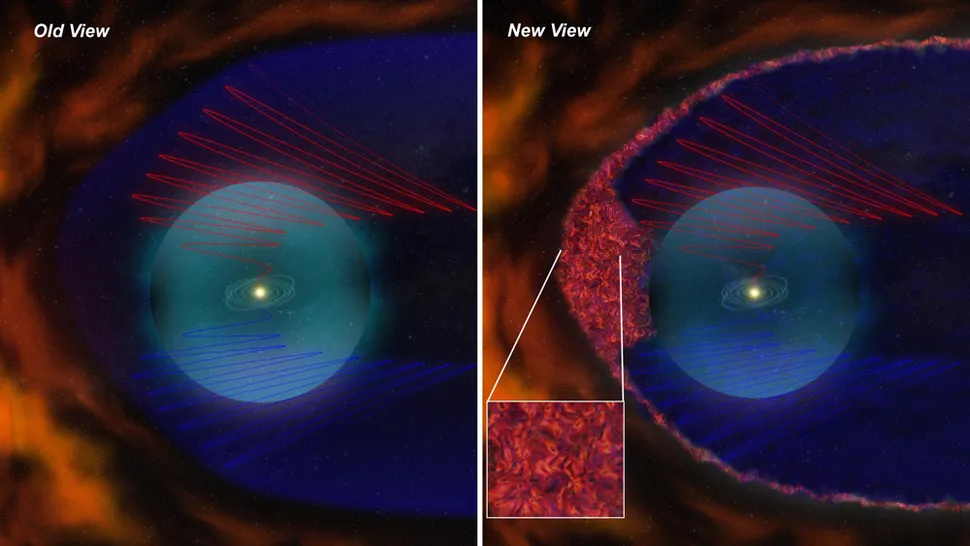When I consider thy heavens, the work of thy fingers, the moon and the stars, which thou hast ordained;
What is man, that thou art mindful of him? and the son of man, that thou visitest him? Psalms 8:3-4
The heavens declare the glory of God; and the firmament showeth his handiwork. Psalms 19:1
Thou art worthy, O Lord, to receive glory and honour and power: for thou hast created all things, and for thy pleasure they are and were created. Revelation 4:11
And once again, scientists have to change their theories. As reported by Michael Wall of Space.com on June 9, 2011:
The edge of the solar system is a turbulent place, filled with a roiling sea of huge magnetic bubbles, new research suggests.
The find, made with the help of observations from NASA's venerable Voyager probes, shakes up prevailing views of the solar system's outer reaches. And it shows that this region, once thought to be a relatively firm shield against interstellar particles such as galactic cosmic rays, is actually more of a porous membrane.
"We will have to change our view of how the sun interacts with particles, fields and gases from other stars," Arik Posner, a Voyager program scientist at NASA Headquarters in Washington, D.C., told reporters today (June 9).
Not smooth, but bubbly
Old and new views of the heliosheath. Red and blue spirals are the gracefully curving magnetic field lines of orthodox models. New data from Voyager add a magnetic froth (inset) to the mix. (Photo credit: NASA)
Our sun's sphere of influence, composed of solar plasma and solar magnetic fields, is called the heliosphere. This gigantic structure is about three times wider than the orbit of Pluto. At the edge of the heliosphere lies the heliosheath, a boundary region between the solar system and interstellar space.
For decades, scientists had thought that, in the heliosheath, the sun's magnetic field curves around in a smooth, consistent arc, forming a relatively uniform structure. [Solar System Explained From the Inside Out]
But that appears not to be the case.
The twin unmanned probes Voyager 1 and Voyager 2, both launched in 1977, are currently plying different parts of the heliosheath, more than 9 billion miles (14.5 billion kilometers) from Earth. And their observations are spurring a rethink of the region. [5 Facts About NASA's Voyager Spacecraft]
Specifically, the probes measured abrupt changes in the flow of particles, such as electrons, from one patch of space to another.
"What really struck us were the sudden differences between what Voyager 1 was seeing and what Voyager 2 was seeing," said study co-author James Drake of the University of Maryland. "We had to explain, well, why is that?"
The best explanation, according to subsequent computer models, is that the probes are flying through a frothy field of magnetic bubbles. These bubbles act as particle traps. So particle readings increase while the spacecraft are inside one, then drop when they exit.
These bubbles form as a result of the interaction between the sun's rotation and its magnetic field. As the sun spins, its magnetic field churns and twists out in the heliosheath. The folded field bunches up on itself, causing lines of magnetic force to crisscross and reconnect, forming the sea of bubbles.
Huge, sausage-shaped bubbles
The sausage-shaped bubbles are gigantic, measuring about 100 million miles (161 million km) across. And there are a lot of them...
...Voyager 1 is now about 11 billion miles (17.7 billion kilometers) from Earth, while Voyager 2 is about 9 billion miles (14.5 billion km) away. Voyager 1 is the most far-flung human-made object in the universe.
The Table of Nations- Genesis
-
What is a biblical family tree if not a family tree? Genesis 10 famously
presents the so-called “Table of Nations,” a long list of the descendants
of Noah,...
7 hours ago






































No comments:
Post a Comment